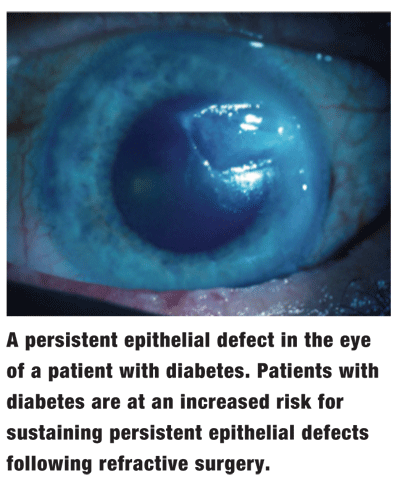 As diabetes becomes increasingly prevalent in the
As diabetes becomes increasingly prevalent in the
This months column addresses special considerations that optometrists must contemplate when referring diabetic patients for either cataract or refractive surgery.
Cataract Surgery Options
Patients who have diabetes mellitus are more prone to developing cataracts than individuals without diabetes, so many of your patients with diabetes will likely require cataract surgery.1
However, there are special considerations for diabetic patients who undergo cataract surgery.
These considerations include:
Disease progression. Following cataract surgery, nearly one-third of those patients with pre-existing diabetic retinopathy show further progression of the condition.2 And, in patients with moderate to severe diabetic retinopathy, macular edema can persist or even worsen following cataract surgery, thus increasing the chances for vision loss.1,3
Optometrists must accurately document the level of retinopathy prior to surgery. This will allow for better postoperative monitoring of potential progression.
Increased inflammation and macular thickening. Both may occur following cataract surgery.3 Be sure to discuss these associated risks with your patients before they decide to undergo cataract surgery. Ideally, cataract surgery should take place before the patient develops significant diabetic retinopathy.
Also, if the patient has retinal neovascularization, refer the patient to a retinal specialist for an evaluation prior to cataract surgery.4,5 The specialist may suggest a laser photocoagulation treatment before the cataract surgery. Ideally, you and the surgeon should jointly decide on the most appropriate IOL for a patient with diabetes. Most often, the surgeon will elect to make a small incision or perform microincision cataract surgery (MICS).
IOL material. A study from
New, advanced IOLs that show great potential for use in people with diabetes should be available in the
One hydrophilic acrylic IOL, the Akreos lens (Bausch & Lomb), showed a 0% PCO rate in the general population after one year of implantation in an early pilot study of 27 patients.9 Other studies show a consistently low rate of patients who required Nd:YAG capsulotomy: only 8.8% after nearly 2.5 years.10
You will need to continuously monitor patients with diabetes for at least six months after they undergo cataract surgery. Subsequently, you may even decide to refer the patients for laser photocoagulation if applicable. While more research specifically pertaining to people with diabetes is necessary, both acrylic IOLs and MICS appear promising for patients with diabetes.
Healing time. You must also consider the skill and expertise of the surgeon you select for care of your patients. Because the eyes of diabetic patients often heal rather slowly following ocular surgery, smaller incisions may benefit your patient.11 In one study, MICS yielded similar results in patients with and without diabetes.12 However, this study also showed more damage of corneal endothelial cells in the patient population with diabetes.12
 Refractive Surgery Options
Refractive Surgery Options
In previous years, systemic diseases, such as diabetes, were considered a contraindication for photorefractive keratectomy (PRK) and/or LASIK. However, new research suggests that the appropriateness of refractive surgery in diabetic patients really depends on how well controlled the patients disease is. Indeed, one study from
Another study largely supported these findings, but the researchers documented less predictable refractive outcomes in patients with controlled diabetes.14 In this study, none of the subjects with well-controlled diabetes experienced a decrease in visual acuity or reported any complications after LASIK.14 However, the enhancement rate among patients with diabetes was 28.3%, suggesting that LASIK candidates with diabetes, like any other LASIK candidates, should be informed about the potential need for enhancement.14
Other studies have shown significantly less predictable refractive outcomes in patients with diabetes and have documented associated epithelial complications, such as superficial punctate keratopathy, recurrent corneal erosions and persistent epithelial defects.15 These less predictable refractive outcomes may be due to consistent myopic and hyperopic shifts caused by varying blood sugar levels.16
Refractive surgery is still contraindicated in patients with either proliferative diabetic retinopathy or poor systemic glucose control.
In one reported case, a patient with proliferative diabetic retinopathy underwent LASIK and subsequently demonstrated rapid and pronounced progression of the retinopathy, which resulted in severe visual loss in both eyes.17
Most contemporary studies consider well-controlled type 2 diabetes a relative contraindication for refractive surgery. However, experts are not as certain about people with type 1 diabetes, as a recent study showed a substantial increased risk for epithelial ingrowth following LASIK in type 1 patients.18
Following cataract or refractive surgery, the presence of diabetes can affect the patients healing time, refractive outcome and progression of retinopathy. We must educate our patients with diabetes about the possible risks, complications and limitations associated with corrective surgeries and make sure that these patients have reasonable expectations.
1. Gupta A, Gupta V. Diabetic maculopathy and cataract surgery. Ophthalmol Clin North Am 2001 Dec;14(4):625-37.
2. Mahtis A, Pago-Mathis V, Dumas S, et al. Retinal complications of cataract surgery. J Fr Ophthalmol 2000 Jan;23(1):88-95.
3. Sadiqu SA, Sleep T, Amoaku WM. The visual results and changes in retinopathy in diabetic patients following cataract surgery. Eur J Opthalmol 1999 Jan-Mar;9(1):14-20.
4. Schrey S. Krepler K, Biowski R, et al. Midterm visual outcome and progression of diabetic retinopathy following cataract surgery. Ophthalmologica 2002 Sep-Oct;216(5):337-40.
5. Menchini U, Cappelli S. Virgili G. Cataract surgery and diabetic retinopathy. Semin Ophthalmol 2003 Sep;18(3):103-8.
6. Ivancic D, Mandic Z, Carac J, et al. Cataract surgery and postoperative complications in diabetic patients. Coll Antropol 2005;29 Suppl 1:55-8.
7. Elgohary MA, Hollick EJ, Bender LE , et al. Hydrophobic acrylic and plate-haptic silicone intraocular lens implantation in diabetic patients: pilot randomized clinical trial. J Cataract Refract Surg 2006 Jul;32(7):1188-95.
8. Kim NJ, Lee JH. Effect of an acrylic posterior chamber IOL on posterior capsule opacification in cataract patients with associated risk factors. J Cataract Refract Surg 2003 Aug;29(8):1575-8.
9. Spath U, Liekfeld A, Hartmann C, et al. Evaluation of posterior capsule opacification after implantation of the Akreos Disk and Akreos Fit acrylic IOLs pilot studies. Klin Monatsbl Augenheikd 2003 Oct;220(10):695-8.
10. Khandwala MA, Majanovic B,
11. Rossini AA. Why control blood glucose levels? Arch Surg 1976 Mar;111(3):229-33.
12. Morikubo S, Takamura Y, Kubo E, et al. Corneal changes after small incision cataract surgery in patients with diabetes mellitus. Arch Ophthalmol 2004 Jul;122(7):966-9.
13. Cobo-Soriano R, Beltran J, Baviera J. LASIK outcomes in patients with underlying systemic contraindications: a preliminary study. Ophthalmology 2006 Jul;113(7):1118.e1-8.
14. Halkiadakis I, Belfair N, Gimbel HV. Laser in situ keratomileusis in patients with diabetes. J Cataract Refract Surg 2005 Oct:31(10):1895-8.
15. Fraunfelder FW, Rich LF. LASIK complications in diabetes mellitus. Cornea 2002 Apr;21(3):246-8.
16. Lee KE, Klein BE, Klein R, et al. Changes in refraction over 10 years in an adult population: the Beaver Dam Eye study. Invest Ophthalmol Vis Sci 2002 Aug;43(8):2566-71.
17. Chandbari H, Ahmadeih H. Aggravation of proliferative diabetic retinopathy after LASIK. J Cataract Refract Surg 2003 Nov;29(11):2232-3.
18. Jabbur NS, Chicani CF, Kuo IC et al. Risk factors in interface epithelialzation after LASIK. J Cataract Refract Surg 2004 Jul-Aug;20(4):343-8.










